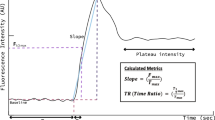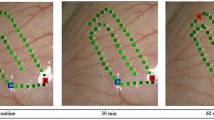Abstract
Background
An objective evaluation of the functional state and viability of biological tissues during minimally invasive surgery remains unsolved task. Various non-contact methods for evaluating perfusion during laparoscopic surgery are discussed in the literature, but so far there have been no reports of their use in clinical settings.
Methods and patients
Imaging photoplethysmography (iPPG) is a new method for quantitative assessment of perfusion distribution along the tissue. This is the first study in which we demonstrate successful use of iPPG to assess perfusion of organs during laparoscopic surgery in an operation theater. We used a standard rigid laparoscope connected to a standard digital monochrome camera, and abdominal organs were illuminated by green light. A distinctive feature is the synchronous recording of video frames and electrocardiogram with subsequent correlation data processing. During the laparoscopically assisted surgeries in nine cancer patients, the gradient of perfusion of the affected organs was evaluated. In particular, measurements were carried out before preparing a part of the intestine or stomach for resection, after anastomosis, or during physiological tests.
Results
The spatial distribution of perfusion and its changes over time were successfully measured in all surgical cases. In particular, perfusion gradient of an intestine before resection was visualized and quantified by our iPPG laparoscope in all respective cases. It was also demonstrated that systemic administration of norepinephrine leads to a sharper gradient between well and poorly perfused areas of the colon. In four surgical cases, we have shown capability of the laparoscopic iPPG system for intra-abdominal assessment of perfusion in the anastomosed organs. Moreover, good repeatability of continuous long-term measurements of tissue perfusion inside the abdominal cavity was experimentally demonstrated.
Conclusion
Our study carried out in real clinical settings has shown that iPPG laparoscope is feasible for intra-abdominal visualization and quantitative assessment of perfusion distribution.







Similar content being viewed by others
References
Urbanavičius L, Pattyn P, de Putte D, Van VD (2011) How to assess intestinal viability during surgery: a review of techniques. World J Gastrointest Surg 3:59–69. https://doi.org/10.4240/wjgs.v3.i5.59
Miyashiro I, Kishi K, Yano M, Tanaka K, Motoori M, Ohue M, Ohigashi H, Takenaka A, Tomita Y, Ishikawa O (2011) Laparoscopic detection of sentinel node in gastric cancer surgery by indocyanine green fluorescence imaging. Surg Endosc 25:1672–1676. https://doi.org/10.1007/s00464-010-1405-3
Park S-H, Park H-M, Baek K-R, Ahn H-M, Lee IY, Son GM (2020) Artificial intelligence based real-time microcirculation analysis system for laparoscopic colorectal surgery. World J Gastroenterol 26:6945–6962. https://doi.org/10.3748/wjg.v26.i44.6945
Hellan M, Spinoglio G, Pigazzi A, Lagares-Garcia JA (2014) The influence of fluorescence imaging on the location of bowel transection during robotic left-sided colorectal surgery. Surg Endosc 28:1695–1702. https://doi.org/10.1007/s00464-013-3377-6
Diana M, Agnus V, Halvax P, Liu Y-Y, Dallemagne B, Schlagowski A-I, Geny B, Diemunsch P, Lindner V, Marescaux J (2015) Intraoperative fluorescence-based enhanced reality laparoscopic real-time imaging to assess bowel perfusion at the anastomotic site in an experimental model. Br J Surg 102:e169–e176. https://doi.org/10.1002/bjs.9725
Chalopin C, Pfahl A, Köhler H, Knospe L, Maktabi M, Unger M, Jansen-Winkeln B, Thieme R, Moulla Y, Mehdorn M, Sucher R, Neumuth T, Gockel I, Melzer A (2022) Alternative intraoperative optical imaging modalities for fluorescence angiography in gastrointestinal surgery: spectral imaging and imaging photoplethysmography. Minim Invasive Ther Allied Technol 31:1–11. https://doi.org/10.1080/13645706.2022.2164469
Schols RM, Bouvy ND, van Dam RM, Stassen LPS (2013) Advanced intraoperative imaging methods for laparoscopic anatomy navigation: an overview. Surg Endosc 27:1851–1859. https://doi.org/10.1007/s00464-012-2701-x
Han Z, Zhang A, Wang X, Sun Z, Wang MD, Xie T (2016) In vivo use of hyperspectral imaging to develop a noncontact endoscopic diagnosis support system for malignant colorectal tumors. J Biomed Opt 21:16001. https://doi.org/10.1117/1.JBO.21.1.016001
Wakabayashi T, Barberio M, Urade T, Pop R, Seyller E, Pizzicannella M, Mascagni P, Charles A-L, Abe Y, Geny B, Baiocchini A, Kitagawa Y, Marescaux J, Felli E, Diana M (2021) Intraoperative perfusion assessment in enhanced reality using quantitative optical imaging: an experimental study in a pancreatic partial ischemia model. Diagnostics 11:93. https://doi.org/10.3390/diagnostics11010093
Clancy NT, Soares AS, Bano S, Lovat LB, Chand M, Stoyanov D (2021) Intraoperative colon perfusion assessment using multispectral imaging. Biomed Opt Express 12:7556–7567. https://doi.org/10.1364/BOE.435118
Pfahl A, Köhler H, Thomaßen MT, Maktabi M, Bloße AM, Mehdorn M, Lyros O, Moulla Y, Niebisch S, Jansen-Winkeln B, Chalopin C, Gockel I (2022) Video: clinical evaluation of a laparoscopic hyperspectral imaging system. Surg Endosc 36:7794–7799. https://doi.org/10.1007/s00464-022-09282-y
Thomaßen MT, Köhler H, Pfahl A, Stelzner S, Mehdorn M, Thieme R, Jansen-Winkeln B, Gockel I, Chalopin C, Moulla Y (2023) In vivo evaluation of a hyperspectral imaging system for minimally invasive surgery (HSI-MIS). Surg Endosc 37:3691–3700. https://doi.org/10.1007/s00464-023-09874-2
Urade T, Felli E, Barberio M, Al-Taher M, Felli E, Goffin L, Agnus V, Ettorre GM, Marescaux J, Mutter D, Diana M (2021) Hyperspectral enhanced reality (HYPER) for anatomical liver resection. Surg Endosc 35:1844–1850. https://doi.org/10.1007/s00464-020-07586-5
Zheng C, Lau LW, Cha J (2018) Dual-display laparoscopic laser speckle contrast imaging for real-time surgical assistance. Biomed Opt Express 9:5962–5981. https://doi.org/10.1364/BOE.9.005962
Heeman W, Dijkstra K, Hoff C, Koopal S, Pierie J-P, Bouma H, Boerma EC (2019) Application of laser speckle contrast imaging in laparoscopic surgery. Biomed Opt Express 10:2010–2019. https://doi.org/10.1364/BOE.10.002010
Potapova EV, Seryogina ES, Dremin VV, Stavtsev DD, Kozlov IO, Zherebtsov EA, Mamoshin AV, Ivanov YV, Dunaev AV (2020) Laser speckle contrast imaging of blood microcirculation in pancreatic tissues during laparoscopic interventions. Quantum Electron 50:33–40. https://doi.org/10.1070/qel17207
Guo Y, Weng Y, Zhang Y, Tong S, Liu Y, Lu Z, Miao P (2023) Random matrix-based laser speckle contrast imaging enables quasi-3D blood flow imaging in laparoscopic surgery. Biomed Opt Express 14:1480–1493. https://doi.org/10.1364/BOE.483655
Heeman W, Wildeboer ACL, Al-Taher M, Calon JEM, Stassen LPS, Diana M, Derikx JPM, van Dam GM, Boerma EC, Bouvy ND (2023) Experimental evaluation of laparoscopic laser speckle contrast imaging to visualize perfusion deficits during intestinal surgery. Surg Endosc 37:950–957. https://doi.org/10.1007/s00464-022-09536-9
Kazmi SMS, Faraji E, Davis MA, Huang Y-Y, Zhang X, Dunn AK (2018) Flux or speed? Examining speckle contrast imaging of vascular flows. Biomed Opt Express 6:2588–2608. https://doi.org/10.1364/BOE.6.002588
Mamontov OV, Shcherbinin AV, Romashko RV, Kamshilin AA (2020) Intraoperative imaging of cortical blood flow by camera-based photoplethysmography at green light. Appl Sci 10:6192. https://doi.org/10.3390/app10186192
Kukel I, Trumpp A, Plötze K, Rost A, Zaunseder S, Matschke KE, Rasche S (2020) Contact-free optical assessment of changes in the chest wall perfusion after coronary artery bypass grafting by imaging photoplethysmography. Appl Sci 10:6537. https://doi.org/10.3390/app10186537
Kamshilin AA, Zaytsev VV, Lodygin AA, Kashchenko VA (2022) Imaging photoplethysmography as an easy-to-use tool for monitoring changes in tissue blood perfusion during abdominal surgery. Sci Rep 12:1143. https://doi.org/10.1038/s41598-022-05080-7
Kashchenko VA, Zaytsev VV, Ratnikov VA, Kamshilin AA (2022) Intraoperative visualization and quantitative assessment of tissue perfusion by imaging photoplethysmography: comparison with ICG fluorescence angiography. Biomed Opt Express 13:3954–3966. https://doi.org/10.1364/BOE.462694
Krasnoselsky KY, Salnikov VG, Shirinbekov NR, Aleksandrovich YS (2019) TIVA manager—component of control of general anesthesia. In: Abstracts of the XVIII International Euroasian Congress of Surgery and Hepatogastroenterology. 11–14 Sept 2019, Baku, Azerbaijan, pp. 330–331
Kamshilin AA, Krasnikova TV, Volynsky MA, Miridonov SV, Mamontov OV (2018) Alterations of blood pulsations parameters in carotid basin due to body position change. Sci Rep 8:13663. https://doi.org/10.1038/s41598-018-32036-7
Lyubashina OA, Mamontov OV, Volynsky MA, Zaytsev VV, Kamshilin AA (2019) Contactless assessment of cerebral autoregulation by photoplethysmographic imaging at green illumination. Front Neurosci 13:1235. https://doi.org/10.3389/fnins.2019.01235
Volynsky MA, Mamontov OV, Osipchuk AV, Zaytsev VV, Sokolov AY, Kamshilin AA (2022) Study of cerebrovascular reactivity to hypercapnia by imaging photoplethysmography to develop a method for intraoperative assessment of the brain functional reserve. Biomed Opt Express 13:184–196. https://doi.org/10.1364/BOE.443477
Acknowledgements
The authors like to thank Mr. Vladimir Artemov from the EFA Medica Ltd for the fruitful discussions and his crucial notes.
Funding
The study was carried out with the financial support of the Russian Science Foundation (Grant No. 21-15-00265) in terms of the manufacture of the experimental equipment, software development, and data processing and analysis. Research planning, patient preparation, and surgical interventions were carried out with the financial support of the Government of the Russian Federation for the state support of scientific research carried out under the supervision of leading scientists (Agreement No. 075-15-2022-1110).
Author information
Authors and Affiliations
Contributions
VK and AK drafted the study plan. AK and VZ developed the conceptual framework for iPPG video analyses, designed and manufactured the technical setup as well as developed the data processing software. VK and AL carried out the surgical interventions. CK provided anesthesia for patients and physiological tests. AK and VK analyzed the experimental data. AK drafted the manuscript. VZ and AK prepared the figures. All authors critically reviewed and approved the manuscript.
Corresponding author
Ethics declarations
Disclosures
Dr. Victor A. Kashchenko, Dr. Alexander V. Lodygin, Dr. Konstantin Yu. Krasnoselsky, Valery V. Zaytsev, and Dr. Alexei A. Kamshilin have no conflicts of interest or financial ties to disclose.
Additional information
Publisher's Note
Springer Nature remains neutral with regard to jurisdictional claims in published maps and institutional affiliations.
Supplementary Information
Below is the link to the electronic supplementary material.
Supplementary file1 (MP4 320219 KB)
Rights and permissions
Springer Nature or its licensor (e.g. a society or other partner) holds exclusive rights to this article under a publishing agreement with the author(s) or other rightsholder(s); author self-archiving of the accepted manuscript version of this article is solely governed by the terms of such publishing agreement and applicable law.
About this article
Cite this article
Kashchenko, V.A., Lodygin, A.V., Krasnoselsky, K.Y. et al. Intra-abdominal laparoscopic assessment of organs perfusion using imaging photoplethysmography. Surg Endosc 37, 8919–8929 (2023). https://doi.org/10.1007/s00464-023-10506-y
Received:
Accepted:
Published:
Issue Date:
DOI: https://doi.org/10.1007/s00464-023-10506-y




